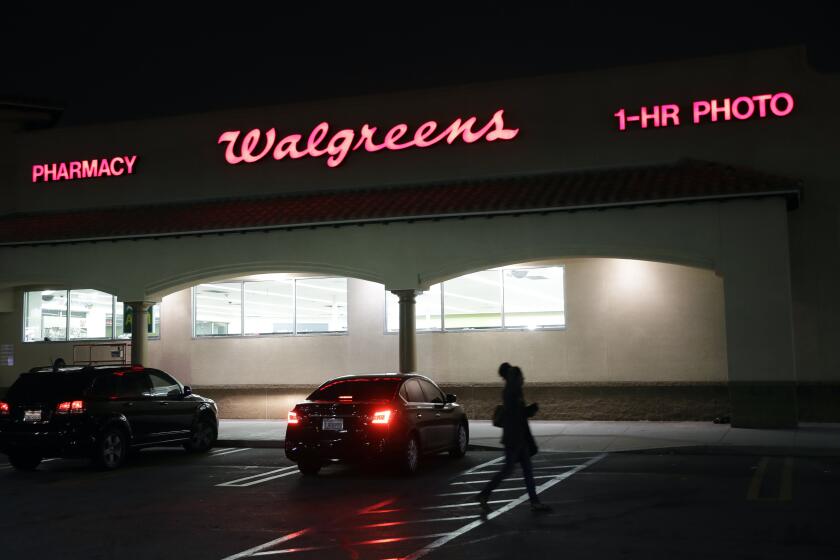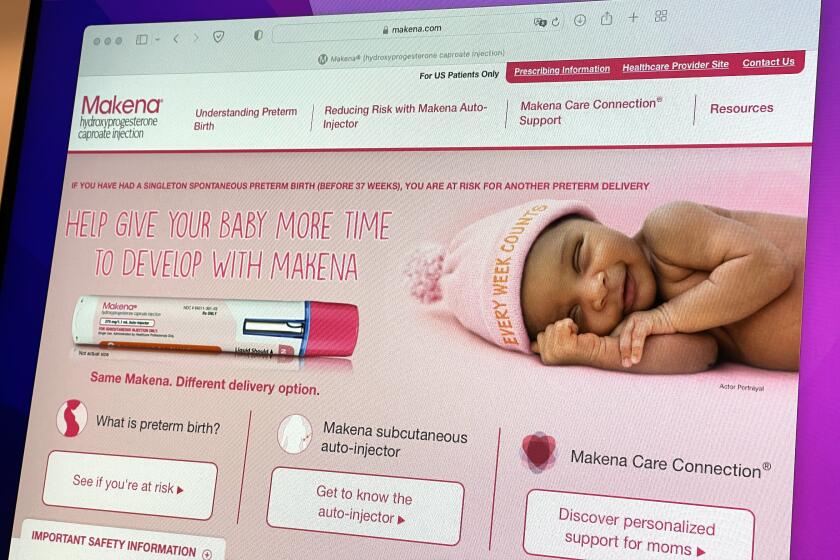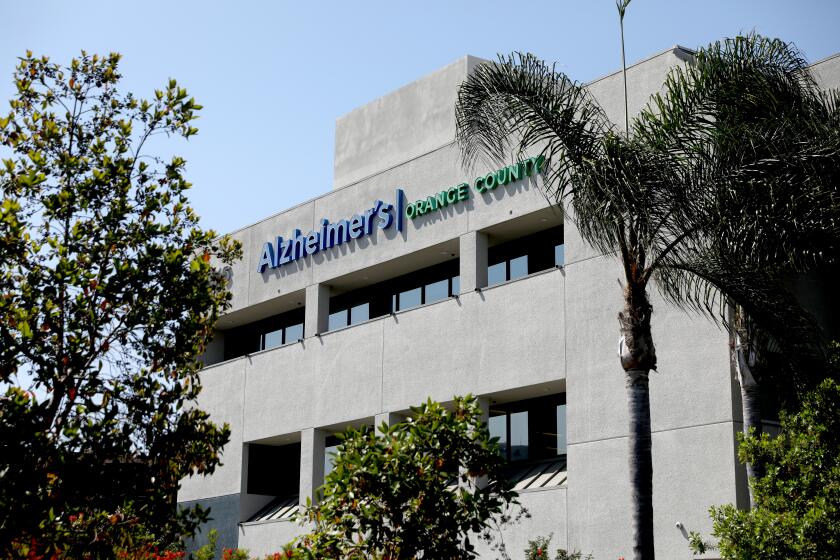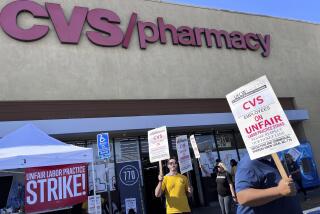California pharmacies are making millions of mistakes. They’re fighting to keep that secret

- Share via
Sharri Shaw walked out of the CVS on Vermont Avenue in South Los Angeles in 2019 believing she had a prescription for the pain reliever acetaminophen.
Instead the bottle held a medicine to treat high blood pressure, a problem she did not have.
Shaw began taking the pills, not learning of the mistake until six days later when a CVS employee arrived at her home, according to a lawsuit she filed last year. The employee told her not to take the tablets, the lawsuit said, before leaving the correct prescription at her door. The mistake, she said, left her stunned.
Shaw’s experience is far from an isolated event. California pharmacies make an estimated 5 million errors every year, according to the state’s Board of Pharmacy.
Officials at the regulatory board say they can only estimate the number of errors because pharmacies are not required to report them.
Most of the mistakes that California officials have discovered, according to citations issued by the board and reviewed by The Times, occurred at chain pharmacies such as CVS and Walgreens, where a pharmacist may fill hundreds of prescriptions during a shift, while juggling other tasks such as giving vaccinations, calling doctors’ offices to confirm prescriptions and working the drive-through.
Christopher Adkins, a pharmacist who worked at CVS, and then at Vons pharmacies until March, said that management policies at the big chains have resulted in understaffed stores and overworked staff.
“At this point it’s completely unsafe,” he said.
Adkins now works at an independent pharmacy company in Los Angeles. He isn’t the only pharmacist worried that heavy workloads and distractions are leading to errors.
In a survey of California licensed pharmacists in 2021, 91% of those working at chain pharmacies said staffing wasn’t high enough to provide patients adequate care.
Although the board requires pharmacies to document errors internally, inform patients about mistakes in certain cases and learn how to prevent them from occurring again, only 62% of chain pharmacists said stores were following those rules, according to the survey.
Every year, millions of Californians leave the pharmacy with the wrong drugs or dosages. Don’t let it happen to you.
Mistakes with deadly consequences
Medication errors can harm patients, sometimes seriously.
One patient took prednisone, a powerful steroid, for 89 days after a Walgreens pharmacist in Santa Clara confused the drug with Prilosec, the heartburn drug that had actually been prescribed, according to a citation issued in June 2022. Research has shown that prednisone can decrease bone density within weeks of starting the drug, increasing the risk of fractures.
In Inglewood, a pregnant patient suffered a fall after she was given two drugs prescribed to another customer by a pharmacist at the CVS on Market Street, according to an August 2021 citation.
At a Rite Aid in Bakersfield, a pharmacist typed the wrong instructions on a prescription for anastrozole, a hormonal treatment for breast cancer. The pharmacist told the patient to take half a tablet twice a day rather than twice a week as the doctor had prescribed. The patient took the drug according to the incorrect instructions for several days, according to a January 2023 citation, suffering “adverse effects.”
Some patients have continued to take and refill the prescriptions without knowing they received the wrong drug. A pharmacist in Adelanto at the CVS on Palmdale Road gave a patient another customer’s prescription for 50-milligram tablets of Zoloft, the antidepressant, according to a February citation. The person took the wrong drug for at least seven months, refilling the prescription three times.
The pharmacy board says it investigates any report of an error that it receives from consumers or others. If the investigation finds that regulations were violated, the board can issue citations and fines and possibly take away the pharmacist’s or pharmacy’s state license.
Adderall, Ozempic, albuterol, antibiotics and lifesaving cancer meds are in short supply. Here are answers to some of the most pressing questions about the situation.
CVS and Walgreens declined to make executives available for interviews but sent statements saying that the errors were rare. Rite Aid did not respond to messages.
“Patient safety is our highest priority,” CVS said in its statement. “When we learn of a prescription error, the first priority of our pharmacy teams is caring for the patient, taking steps to correct the error, working with the patient and the prescriber.”
CVS said it does not comment on litigation.
Walgreens said it has “a multi-step prescription filling process with numerous safety checks to minimize the chance of human error.”
“When errors do occur, we also have a robust mandatory reporting system in place that allows us to quickly identify root causes and to implement process improvements to prevent future errors,” Walgreens said.
Vons said in a statement that the company makes sure pharmacies are appropriately staffed. “We also regularly review the workflow in our pharmacies to identify ways to streamline and automate non-patient facing tasks so that our pharmacy teams can dedicate more time to serving our customers,” the company said.
Some errors have been deadly. More than 10% of malpractice claims against pharmacists were for injuries that resulted in death, according to a 2019 report by two insurance providers.
The leading cause of death was from overdoses, in which patients were given dosage strengths that were too high or incorrect instructions that multiplied the amount of medicine the patient received.
As many as 9,000 Americans die each year from prescription errors, according to one study.
Covis Pharma said it told the Food and Drug Administration that it would voluntarily withdraw the medicine called Makena, which a study in 2019 showed did not work to extend pregnancies.
‘Virtual verification’
The chain pharmacies told The Times they are using technology to give pharmacists more time to keep patients safe.
Walgreens said, for example, it uses “micro-fulfillment,” in which prescriptions are filled by robots at regional centers.
One method of automation used by CVS is mentioned in at least seven citations by the pharmacy board since July 2022. The technique, called “virtual verification,” allows a pharmacist to sign off on a prescription without seeing what pills are put in the bottle.
Instead a lower-paid technician, hired to help the pharmacist, finds the drug to fill the prescription, counts the pills and then snaps a photo just before putting the tablets in the bottle and stapling the bag shut. The pharmacist approves the prescription based on the photo rather than actually observing the pills.
According to a June 2022 citation, one patient received a bottle of Valtrex, which treats viral infections, rather than the prescribed Keflex, which treats bacterial illnesses, from the CVS on Lankershim Boulevard in North Hollywood.
“Pharmacist verification based on the photograph … obstructs the pharmacist’s ability to verify the prescription,” the regulators wrote on the citation, which imposed a $5,000 fine.
Since those citations were issued for errors, the board agreed to withdraw the part of its findings related to virtual verification at five pharmacies after meeting with CVS executives, according to a letter the board sent to the company. The executives told board officials that they had improved the process, including by making it easier for pharmacists to see the pills in the photographs. The board said it “remains concerned” that relying on photos could increase errors, the letter said. CVS told the board it has not seen an increase.
A gold rush in Alzheimer’s pharmaceutical research raises questions about whether aging seniors being recruited for trials in California understand the process and possible risks.
The fight for more accountability
Rarely does the public learn of the mistakes. Not only does the state not require the reporting of errors, but the big pharmacy companies often ask consumers to sign agreements demanding that they take any dispute not to court but to private arbitration panels.
Patients typically agree to arbitration when they are asked to click a box to accept the company’s terms and conditions when they pick up a prescription.
“You agree that CVS and you each waive the right to trial by a jury,” states the CVS agreement.
To begin understanding the frequency of the mistakes, the pharmacy board sponsored a bill that would require pharmacies to report every error — not publicly but to a third party outside the government. The bill would also give the pharmacist responsible for the store the ability to increase staffing if they believe the workload has become too heavy to keep patients safe.
The legislation is opposed by the California Community Pharmacy Coalition, a lobbying group representing retail pharmacies, including the big chains. The coalition has told legislators that the pharmacy staffing requirements are too rigid and that it does not want the pharmacy board to have access to the error reports, among other objections with the bill. The coalition did not respond to a request for comment.
Language in the bill being debated in Sacramento states that the board would not get access to the reports — and neither would the public. Instead the reports would be kept confidential. The third-party group receiving the error reports would periodically provide information to the pharmacy board, including how many mistakes have been reported.
The pharmacy board said it hopes to use the information to learn more about what is causing the errors and what can be done to reduce them. The bill would allow the board to publish de-identified information compiled from the data in the reports.
Federal regulators are increasingly approving medicines before studies have shown they work, leaving patients at risk of taking prescriptions that could harm but not help them.
The bill, AB 1286, authored by Assemblymember Matt Haney, a San Francisco Democrat, has passed the Assembly and is now before the state Senate.
“Shockingly, there’s no centralized reporting mechanism for medication errors,” Haney said in an interview. “There should be transparency, and the Board of Pharmacy should have the authority to respond to protect patients. That’s not happening right now.”
Two years ago, the state Legislature passed a bill that banned chain pharmacies from setting quotas for pharmacists on the numbers of prescriptions filled, vaccines given or other activities during a shift. The law’s goal was to make the chain pharmacies safer.
In the 2021 survey, taken before that bill passed, 73% of chain pharmacists said their employer monitored the number of prescriptions filled and 62% said the company monitored the average time it took them to fill a prescription.
Despite the new law, some chain pharmacies have continued to require pharmacists to meet quotas, according to citations issued by the board. Since January 2022, at least five pharmacies have been cited for asking pharmacists to meet quotas.
CVS set quotas and measured pharmacists on the number of vaccinations they gave each week, according to a March citation issued to the company’s pharmacy in Ripon, a town in the Central Valley. The citation included a $10,000 fine.
CVS declined to answer questions about the citation. It said it did not set quotas for pharmacists or pharmacy technicians.
A pharmacy board inspection at a Walgreens in Citrus Heights in August of last year found that the store had set quotas for pharmacists on the number of COVID-19 tests dispensed and vaccinations given.
The quota was “expressly encouraged by Walgreens corporate ownership,” the citation said. The pharmacy was fined $50,000, and an additional $5,000 for the inspectors’ finding that a pharmacist had dispensed a prescription of atenolol, a blood pressure medicine, without consulting with the customer about how to safely take it. That consultation is required by state law if the drug hasn’t been given to the patient previously.
Walgreens said it disagreed with the citation and was challenging it. “Walgreens does not utilize quotas for pharmacists or pharmacy technicians,” the company said, “and was in compliance with the new law before it went into effect.”
In a nationwide move last fall, Walgreens announced that it would no longer evaluate its pharmacy staff on any task-based metrics.
Adkins, the former chain pharmacist, said that when he began working at CVS pharmacies in the Bay Area in 2020, he accidentally gave a customer another patient’s prescription.
He said he was the only person in the pharmacy at the time.
“I was having to go back and forth between the register and filling prescriptions and answering the phones, and one patient came in to pick up a medication, which wasn’t ready because I was behind,” Adkins said. “So I had to go get it ready really quickly.”
He gave the customer her prescription and realized after she left that he had made a mistake.
Adkins said he quickly called the customer, finding she was still in the parking lot. Although the patient ultimately received the correct prescription, he said, she was angry at the dangerous mistake.
“It was my fault,” Adkins said. He said he believes it would not have happened if he’d had staff to help him.
“The public does not realize what’s going on behind the counter,” he said.
- Share via
More to Read
Inside the business of entertainment
The Wide Shot brings you news, analysis and insights on everything from streaming wars to production — and what it all means for the future.
You may occasionally receive promotional content from the Los Angeles Times.

















